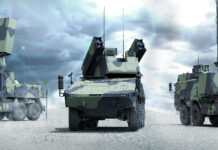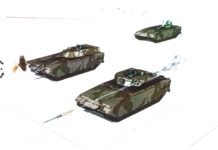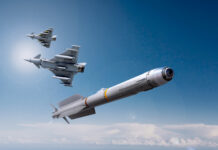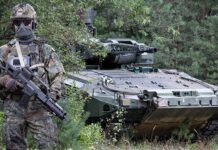Current Future Soldier programmes aim to upgrade infantry capabilities through technology, but display more realistic goals than some previous initiatives.
From Afghanistan to Ukraine, modern conflicts have proven that dismounted infantry remain the decisive military force. Airpower, artillery and armoured vehicles are of course indispensable, but ultimately serve to enable the infantry to conquer the proverbial ‘last 100 yards’ of the battlefield. Dismounted soldiers’ role is even more prominent in post-conflict, peacekeeping or counterinsurgency operations.
Armed forces regularly upgrade infantry gear, with an eye to enhancing both survival and lethality. The first decade of the current century was marked – especially in the United States – by some highly ambitious projects which aimed to leverage conceptual technology to create ‘super soldiers’ equipped with strength-multiplying exoskeletons and ‘Iron Man’ suits offering ballistic protection and integrating non-traditional weapons options. After years of research it became evident that such concepts still belonged, at least for the time being, to the realm of science fiction.
French Army
Programmes with more moderate parameters, such as the French Army’s FELIN (Fantassin à Équipement et Liaisons Intégrés; ENG: ‘Infantryman with Integrated Equipment and Communications’), were more readily implemented. The industry team led by Safran Electronics and Defense delivered circa 23,000 FELIN sets to the French Army between 2010 and 2015. The system is operational with airborne, mountain and mechanised infantry units, and was successfully deployed in Afghanistan, and Africa. The modular system includes improved communications gear and sensors, infantry weapons and advanced aiming aids, ballistic protection and ergonomically optimised uniforms and harnesses. The kit can be configured to meet mission parameters and the role of the individual soldier within the unit or echelon.

Credit: French Army
Immediately after completing procurement of the original FELIN kits, the DGA (Direction générale de l’armement; ENG: General Armaments Directorate) in 2016 awarded Safran the contract to upgrade the system to the FELIN V1.3 standard. Improvements include software upgrades for targeting sensors and fire support, more modular protective gear, and enhanced combat vests optimised for the SitComdé tactical terminal and battle management system. V1.3 promised to reduce system weight by 40% without compromising protection. Then in 2019 the DGA launched the Centurion initiative. The programme runs through 2026 and aims to accelerate innovation by French industry and integrate new technologies into existing programmes including future increments of FELIN.
The goal is to enhance “individual, collective and collaborative capabilities of the fighter” through technologies such as connectivity and communication, positioning and navigation, innovative interfaces, protective and stealth equipment, mobility aids, observation and identification means, innovative energy sources, soldier health monitoring, and functionalised textiles.

Credit: French Army
Other countries’ ongoing Future Soldier System programmes are following the same approach of systematically adopting incrementally-improved equipment and new materials, and fielding them as holistically balanced packages to improve soldier performance. Wearable electronics and advanced networking capabilities are considered vital elements in all of these programmes. The US Army and the German Army present two typical approaches.
US Army
The US Army’s current infantry modernisation effort is focussed in several compartmentalised, parallel but independent projects to develop new infantry weapons, wearable sensors and situational awareness tools, and personal protective equipment (PPE). The Next Generation Squad Weapon (NGSW) programme, the Integrated Visual Augmentation System (IVAS) and the Enhanced Night Vision Goggles – Binoculars (ENVG-B) are among the Army’s highest priority or ‘signature’ development efforts. Their development is being guided by the Army Futures Command’s Soldier Lethality cross-functional team.
NGSW
The NGSW system consists of four elements. The XM7 rifle will replace the M4 carbine. The belt-fed XM250 automatic rifle will replace the M249 light machine gun. Both gas-operated weapons are being developed by Sig-Sauer under a 2022 contract. They will be equipped with the optional ‘smuzzle’, a combined sound suppressor and muzzle brake developed by Army engineers. Army testing shows the smuzzle provides a 33% reduction in felt recoil, 25% reduction of flash signature downrange, and 50% reduction in acoustic signature.
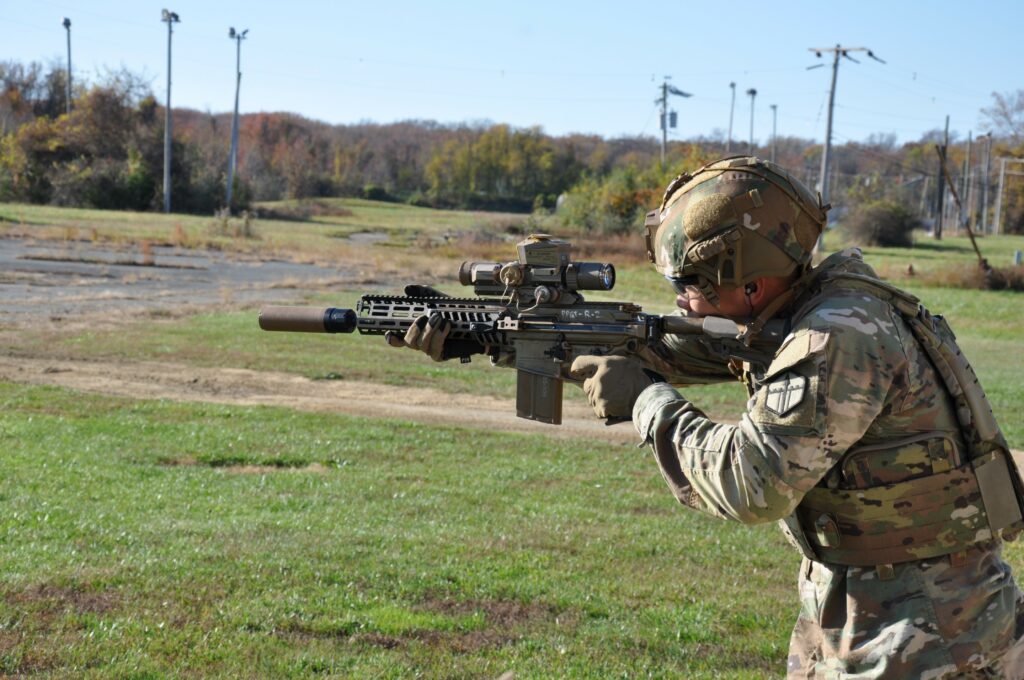
Credit: US Army
The NGSW-Fire Control (NGSW-FC) is an integrated optic system designed to provide enhanced target acquisition and aim correction for both weapons. The design contract was awarded to Vortex Optics in 2022. The FC’s main components include a variable-power scope, a laser rangefinder, a ballistics computer, a disturbed reticle (referring to two aim-points observed when looking through the sight, with one aim point aligned with boresight, and the second tracking the electronically ‘tagged’ target), and a wireless link to soldier devices. It autonomously calculates range, wind and elevation and adjusts the aim point accordingly, while projecting target location, distance, and status to the soldier’s display.
The final component of the NGSW is the new 6.8 × 51 mm (.277 Fury) cartridge designed for its greater projectile weight and muzzle velocity over the M4’s 5.56 × 45 mm ammunition. Overall, NGSW is expected to significantly increase range, accuracy, and target penetration over current infantry weapons; the Army’s stated goal is “achieving overmatch against global adversaries and threats that emerge on the battlefield of today and tomorrow.” The system recently completed production qualification testing, and the first operational unit is scheduled to be equipped with NGSW during the second quarter of FY 2024. The Army plans to procure 250,000 XM7s and 150,000 XM250s over a ten-year period.
IVAS
IVAS is derived from Microsoft’s Hololens 2 headset, which uses holographic technology to overlay digital imagery over real-world imagery. According to Microsoft, the system combines the HoloLens’ mixed-reality technology with thermal imagery, sensors, GPS technology and night vision capabilities in order to improve soldiers’ situational awareness and impart tactically-relevant information. Holographic images, three-dimensional terrain maps and a compass are superimposed onto the heads-up-display (HUD) of the otherwise transparent lens. This includes reconnaissance and targeting data from the squad’s unmanned aerial vehicles (UAVs). Major components are the helmet-mounted visor, a computer (called the ‘puck’) worn on the body, a networked data radio and three conformal batteries. A wireless interface connects the goggles to a family of weapon sights, projecting the weapon reticle and a thermal image of the target onto the goggle display; this enables soldiers to remain under cover while extending their weapons – even around corners – in order to aim and fire at enemies.
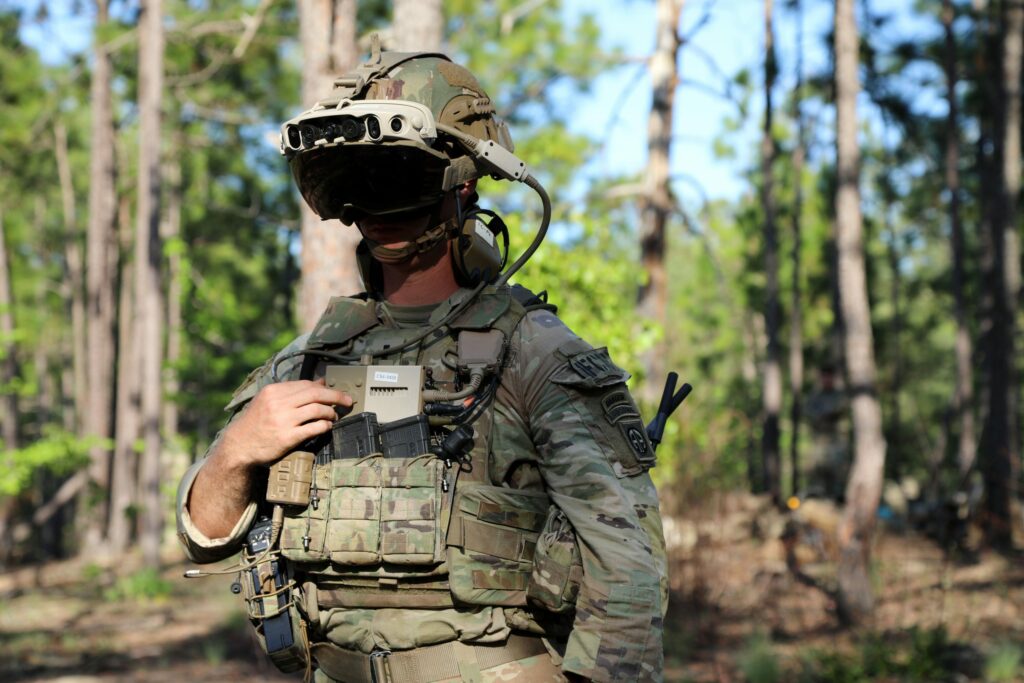
Credit: US Army
Initial IVAS 1.0 demonstrators were tested by troops in 2022, followed in short order by improved IVAS 1.1 prototypes. Soldier feedback has exposed numerous issues such as disorientation and neck strain which are to be alleviated with iteration 1.2. The first IVAS 1.2 prototypes were delivered in July 2023, with operational fielding expected in 2025.
ENVG-B
The helmet-mounted Enhanced Night Vision Goggle-Binocular (ENVG-B) developed by L3Harris combines white phosphor image intensification and long-wave infrared (LWIR) thermal imaging to create an enhanced view of the battlefield under low-light and degraded visual conditions. By integrating with the NETT Warrior system (described below), the goggles can also display maps, navigation, and blue force tracking. Like IVAS, the ENVG-B is intended to enhance mobility, survivability, and lethality in complex environments by significantly expanding situational awareness and improving soldiers’ ability to identify and engage targets. The Army plans to acquire 40,000 units through 2028.
NETT Warrior
NETT Warrior (NW) is an integrated situational awareness system for dismounted infantry leaders (team level and above). The cross-platform system uses the handheld military radio as an interface to link a commercial off-the-shelf (COTS) smartphone into the brigade-level command and control network. Via the smartphone, the soldier can access apps to track friendly forces, coordinate movements with other units, request fire support, send messages and share data; the system can also network with sensors of small unmanned ground vehicles (UGVs) and UAVs. NW employs the map-based Tactical Assault Kit (TAK) situational awareness software suite along with custom applications. The system was introduced in 2010, but has undergone several iterations to date, both to enhance performance and to reduce weight. The third increment is currently undergoing testing, and could be delivered to selected units in 2024. A major goal of the newest design is enhanced artificial intelligence to optimise the interface with other new Future Warrior equipment.
Soldier Protection System (SPS)
The SPS body armour system entered production (depending on the component) between 2016 and 2019, and consists of: Torso and Extremity Protection (TEP), which includes the Modular Scalable Vest (MSV), the lightly armoured, flame-resistant Ballistic Combat Shirt and the Blast Pelvic Protector to reduce the risk of groin injury; the Vital Torso Protection (VTP) set of front, back and side armour plates for insertion into the MSV; and the Integrated Head Protection System (IHPS) consisting of a base helmet which can be augmented with mandible armour and goggles. The SPS is intended to provide equal or greater degrees of protection than legacy body armour against small arms fire and fragmentation, but at reduced weight. The modular system’s individual components can be configured for various tiers of protection to meet mission parameters and soldier needs.
Three elements of the SPS are currently being upgraded. The new components are the Second Generation Modular Scalable Vest (MSV Gen II), the Third Generation Vital Torso Protection (VTP Gen III), and the Next Generation Integrated Head Protection System (NG-IHPS). MSV Gen II and VTP Gen III began early fielding in 2021. Ballistic testing is ongoing, and failure rates so far remain below 5%. The Army plans to acquire 150,000 of each system subset.
German Army
Germany’s Infanterist der Zukunft (IdZ) (ENG: Infantryman of the Future) programme was initiated in 2004 as an urgent operational requirement to equip personnel deployed to Afghanistan. The initial IdZ – BS (Basissystem; ENG: Base System) phase was based on COTS components in order to speed up implementation. The currently fielded iteration is designated IdZ – ES (Erweitertes System; ENG: Expanded System) Gladius. Development began in 2006 by prime contractor Rheinmetall Defence Electronics, with deliveries beginning in 2013. The ‘ES’ suite was conceived as a clean-sheet development because, as the German army stated, “the essential capabilities required by the infantryman can only be fulfilled via a closed and coordinated system approach.” In addition to performance enhancement, the new equipment is also optimised for ergonomic comfort and weight reduction, improving soldier mobility, and reducing fatigue or risk of injury.

Credit: German Army
The German armed forces currently have circa 165 platoon-equivalent kits, sufficient to equip 6,600 servicemembers (mostly Army, although other services have been provided a limited number of kits as well). IdZ consists of three subsystems: BST (Bekleidung, Schutz- und Trageausstattung; ENG: Clothing, Protective and Load-Carrying Equipment), WOO (Weapons, Optics and Optronics), and C4I (Command, Control, Computers, Communications and Information). The entire system is modular, permitting elements from each subsystem-group to be put together to meet the needs of either light or mechanised infantry or reflect an individual soldier’s function within the unit. The common core is formed mostly of vest-mounted communications and networking equipment including a USB hub (into which electronic communications, data and sensor devices are plugged), tactical radios, a visual display unit, digital navigation devices, multiple conformal batteries, and a communications headset. This core is augmented by selecting from nearly 80 options organised into various categories including helmet- and weapon-mounted vision modules and fire control units, multi-mode binoculars, augmented reality devices, numerous customisable firearms and grenade launchers, and personal protective equipment (PPE).
The IdZ family continues to be upgraded regularly, and is considered one of the most advanced infantry systems in the world. Regarding the BST and WOO subsystems, recent improvements have largely focussed on reducing weight and improving user-friendliness.
Individual sensors and sights have incrementally improved performance, and the greatest effort is now being placed on C4I systems as the key to tying all elements together into a force multiplier package. Deliveries of the newest IdZ iteration, designated ‘IdZ-ES VJTF 2023’, began in 2021, with additional orders placed in January 2023. This variant is optimised for the German contingent leading the NATO Very-high-readiness Joint Task Force (VJTF) in 2023. New aspects include upgraded software-defined radios as well as enhanced situational awareness and target acquisition features; these include the chest-mounted CeoTronics CT-MultiPTT 3C central operation and control unit which displays blue-force locations on a tactical map. The IdZ-ES VJTF 2023is compatible with the German military’s new Digitised Land-Based Operations (D-LBO) programme, which is designed to provide a framework for mobile command and control (C2) networks.
Together with upgraded electronics and communications equipment on the Puma infantry fighting vehicle (IFV) and other armoured combat vehicle classes, the IdZ-ES VJTF 2023 also forms the basis for the System Panzergrenadier which will deploy for the first time with the NATO VJTF. The System Panzergrenadier fully networks vehicle sensors and weapons with those of the mounted and dismounted mechanised infantry, creating a seamless common operating environment. This amalgamation of dismounted infantry and IFVs into a true fighting unit enables opposing forces to be detected, identified, and effectively engaged at greater range and with improved precision. With this, the German Army has set a new baseline for integrating dismounted infantry with their IFVs.

Credit: Rheinmetall
In 2021 the German Army tasked Rheinmetall with initiating a study for the next generation Future Soldier System, to be designated IdZ 3.0. It will build on the digital backbone of the current variants, while incorporating new hardware. Full details have not yet been decided, although a few new components are known. These will include the new G95A1 and G95KA1 assault rifles (more widely known as the HK416 A8) which will begin replacing the current G36 as of 2024. New sensors and weapon sights are also expected.
One is the FCS 12 fire control system which combines several functions including day or night weapon sight, laser rangefinder, ballistic computer, and video recorder. As Jan Gesau, First Director of the Bundesamt für Ausrüstung, Informationstechnik und Nutzung der Bundeswehr (BAAINBw) or Federal Office of Bundeswehr Equipment, Information Technology and In-Service Support, stated in an interview in the August 2023 edition of this publication, findings of the relevant studies “will be continuously incorporated into the design of the next steps towards the realisation of the third generation” of the IdZ system.
An Unending Road
Ultimately, ‘the future’ is always one step ahead of any ongoing programme. Once a particular suite of equipment enters service, the military must begin planning the next system of upgrades in order to keep pace with technology and with potential adversaries. In this, the German, French and US land forces – and all of their counterparts – face the truth that the only constant is change.
Sidney E. Dean




